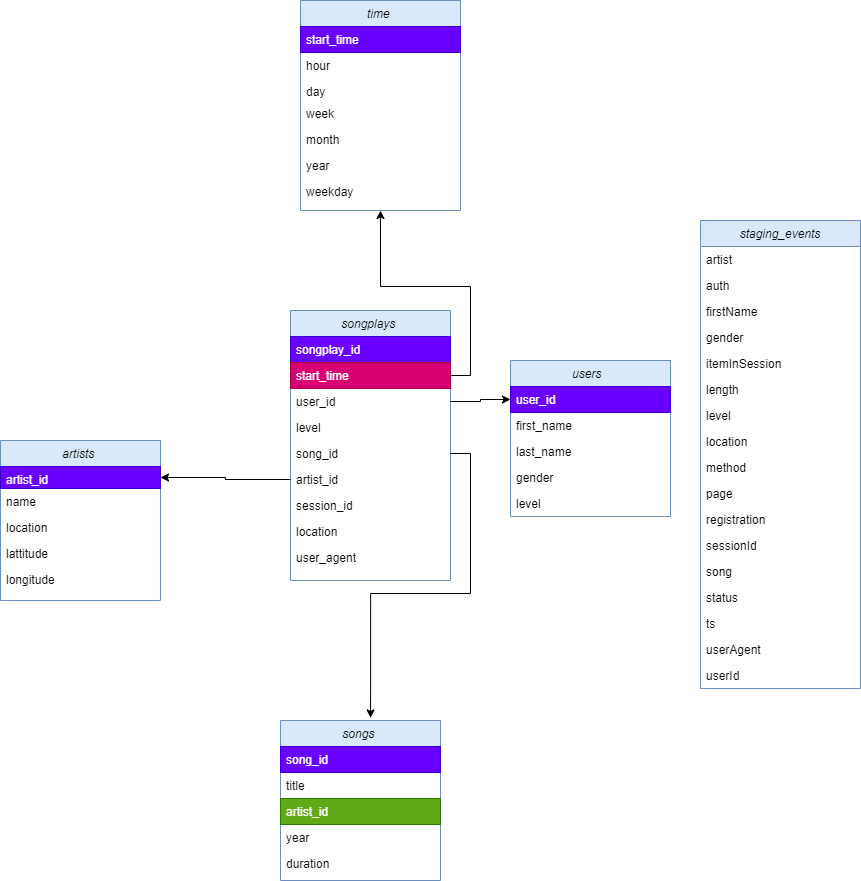This project was provided as part of Udacity's Data Engineering Nanodegree program, you can see all the Nano Degree projects from here.
A music streaming startup, Sparkify, has grown their user base and song database and want to move their processes and data onto the cloud. Their data resides in S3, in a directory of JSON logs on user activity on the app, as well as a directory with JSON metadata on the songs in their app.
In this project, we will create an ETL pipeline to build a data warehouses hosted on Redshift. In this project, we will build an ETL pipeline for a database hosted on Redshift.through loading data from S3 to staging tables on Redshift and execute SQL statements that create the analytics tables from these staging tables.
we have two datasets that reside in S3. Here are the S3 links for each:
-
Song data
-
Log data
-
Log data json path
The first dataset is a subset of real data from the Million Song Dataset. Each file is in JSON format and contains metadata about a song and the artist of that song. The files are partitioned by the first three letters of each song's track ID. For example, here are file paths to two files in this dataset.
song_data/A/B/C/TRABCEI128F424C983.json
song_data/A/A/B/TRAABJL12903CDCF1A.json
And below is an example of what a single song file,
TRAABJL12903CDCF1A.json, looks like.
{"num_songs": 1,
"artist_id": "ARJIE2Y1187B994AB7",
"artist_latitude": null,
"artist_longitude": null,
"artist_location": "",
"artist_name": "Line Renaud",
"song_id": "SOUPIRU12A6D4FA1E1",
"title": "Der Kleine Dompfaff",
"duration": 152.92036,
"year": 0}
The second dataset consists of log files in JSON format generated by this event simulator based on the songs in the dataset above. These simulate app activity logs from an imaginary music streaming app based on configuration settings.
The log files in the dataset you'll be working with are partitioned by year and month. For example, here are file paths to two files in this dataset.
log_data/2018/11/2018-11-12-events.json
log_data/2018/11/2018-11-13-events.json
And below is an example of what the data in a log file.
2018-11-12-events.json, looks like.
Sparkify want to convert to the cloud, so used the architecture below. to create analytical system to able same quary to track the user action and provide best experience for users and help Sparkify to make some decisions.
from the below figure the app will collect all the user date and events and store it on AWS S3 and then using etl code hosted on AWS EC2 will extract the data from the AWS S3 and transform it to data warehouse format then load it into the AWS Redshift and use it to get some analysis queries and get results to decision maker.

the below image represents the
songplays records in log data associated with song plays i.e. records with page NextSong
songplay_id, start_time, user_id, level, song_id, artist_id, session_id, location, user_agent.
users
users in the app
user_id, first_name, last_name, gender, level
songs
songs in music database
song_id, title, artist_id, year, duration
artists
artists in music database
artist_id, name, location, latitude, longitude
time
timestamps of records in songplays broken down into specific units
start_time, hour, day, week, month, year, weekday
and staging_events
artist, auth, firstName, gender, itemInSession, lastName, length, level, location, method, page, registration, sessionId, song, status, ts, userAgent, userId
- prepare Environment install python
- insert the configuration of your AWS account and the role which will be used on dwh.cfg file
HOST is AWS Redshift endpoint
DB_NAME is the name of the redshift database
DB_USER is the name of the redshift database user
DB_PASSWORD is the password to access the redshift database
DB_PORT is the port to access the redshift database
ARN IAM role to access the s3 which has dataset
- run
create_tables.pyfrom terminal or cmd through the below command line or any python IDE to create tables on redshift.
python create_tables.py
- run
etl.pyfrom terminal or cmd through the below command line or any python IDE to load data from AWS s3 bucket and insert into the Aws redshift.
python etl.py
- don't forget to close any service opening to avoid extra chargings
A python script to start connection with AWS and create and configure the tables on AWS Redshift.
a configuration file to configure the connection on AWS Redshift like HOST, DB_NAME, DB_USER, DB_PASSWORD, DB_PORT, ARN and the links of the dataset.
A python script to start connection with AWS and load and insert the dataset into AWS Redshift.
A python script has a sql queries to drop and create tables on data warehouse and execute other SQL queries to insert into the tables.
- juputer notebook
- python
- AWS Redshift
- text editor
I'm mohamed bekheet, you con browser other repository on my github profile and view my linkedin page and kaggle profile and you can contect with me throgth mohamedbekheet33@gmail.com


